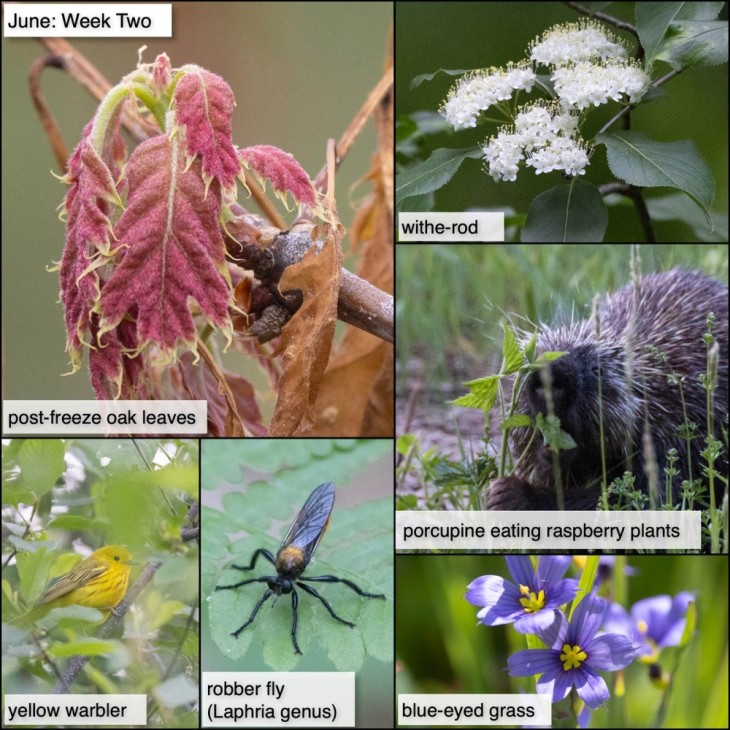In the third week of May, the Connecticut River Upper Valley experienced two unseasonably cold nights in a row, and in some places temperatures dropped to the low twenties or lower. This freeze killed off many trees’ emerging foliage, although some species, such as maples, fared much better than others, such as oaks. The good news is that healthy trees have enough caloric reserves to produce replacement foliage, and they’ve been doing so very quickly; if you inspect an affected tree, you’ll likely find new growth along the branches. This image shows post-freeze red oak leaves.
Withe-rod, also called wild raisin, is in bloom. There’s a lot to like about this wild viburnum, including its frothy white flowers, bright red fall color, and its masses of pink-then-blue berries, which are a major draw for birds as well as other wildlife.
You don’t usually see porcupines out in the middle of field, but that’s where we found this one, munching away on black raspberry leaves. Biologist Uldis Roze, writing in his excellent book, The North American Porcupine, noted that raspberries were the only ground vegetation that he’d observed porcupines eating – and that these plants are a preferred spring food. He suggested that porcupines may seek out raspberries because the plants are low in tannins and (for plants) high in proteins.
Blue-eyed grass, which isn’t blue-eyed or a grass, is a gorgeous little wildflower that is blooming now in fields and other sunny places. There are multiple species of blue-eyed grass in the Northeast, most of them very similar in appearance, and all having some variation of the needle spikes you see at the end of the petals. In addition to being small, these flowers are sneaky – even when you know where a patch is located, when the flowers close up in the afternoon or don’t open on cloudy days, it’s really hard to find the plants.
We found our first robber fly of the season, perched on a fern by a woodland trail. Robber flies in the Laphria genus, such as this one, are bee mimics – a trick that protects them from birds and perhaps other predators. They are insect and spider predators that seize prey, inject them with enzymes, and then – once the enzymes have done their work – sip out the soupy insides. Pro tip – although they don’t sting and aren’t aggressive to people, they are known to bite when messed with – and a bite that can liquify an insect, can cause intense pain and swelling in a hand.
Finally, here’s our best-but-not- great image of a yellow warbler who kept hopping out of the canopy near a river – and then hopping back behind the leaves again. These beautiful birds are relatively common, and you can catch glimpses of their bright yellow feathers as they hunt insects in young forest stands and forest edges. We often find them in alder stands, probably because both these birds and alders like waterside habitats.
What have you noticed in the woods this week? Submit a recent photo for possible inclusion in our monthly online Reader Photo Gallery.


